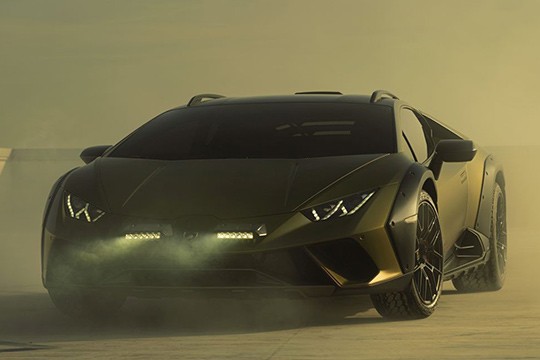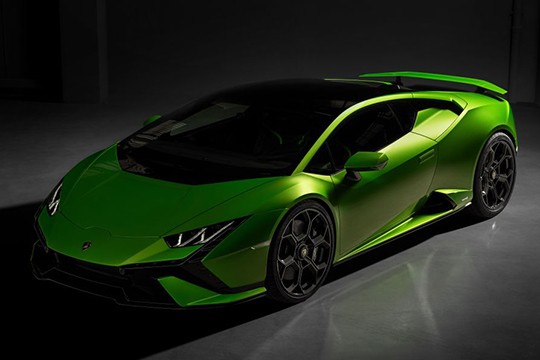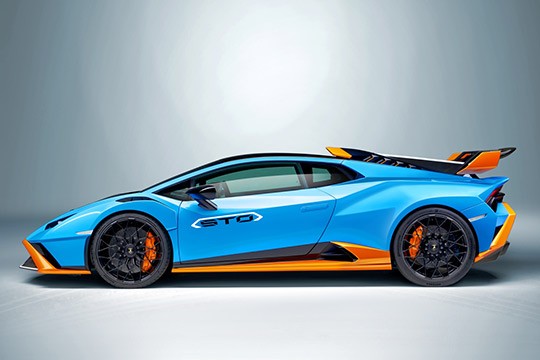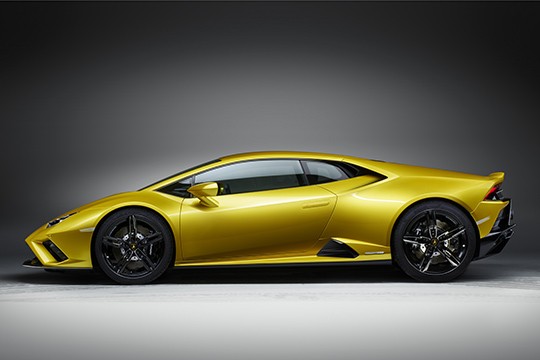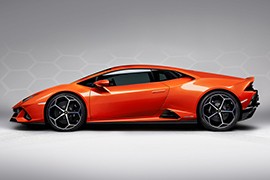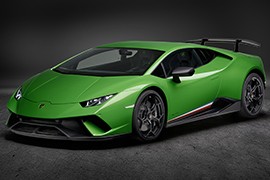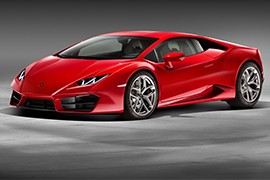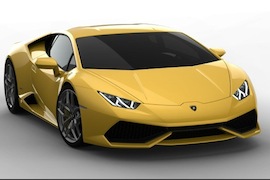LAMBORGHINI Huracan Models/Series Timeline, Specifications & Photos
First production year: 2014
Engines: Gasoline
Body style: Coupé (two-door)
Transforming a supercar into an off-road vehicle was something that nobody could expect from Lamborghini, but that's exactly what the Italian car manufacturer did with the Sterrato version of the Huracan.
Lamborghini didn't have a great experience with off-road vehicles. Besides the old LM002 that was developed for the army and the Urus, which was based on the same platform as the Porsche Cayenne, the Sterrato was like nothing else. But still, Lamborghini pulled this idea to increase the ground clearance of a Huracan, adding some off-road-inspired features, and sell it to those who didn't want to stick to paved roads at all times. Furthermore, the car manufacturer even carried over a few ideas from the Huracan STO, which was mainly designed for track use.
Right off the bat, the Huracan Sterrato featured a radical front fascia that still sported the broad air intake on the lower side of the bumper. But unlike the rest of the range, it had an aluminum skid plate underneath to protect the underbody from scratches. Another unusual feature of the vehicle was the twin LED fog lamps that flanked the carmaker's raging bull logo placed on the hood.
From its profile, the higher ground clearance was raised by 40 mm (1.6 inches) compared to the rest of the Huracan range. Sure, that didn't allow it to pass some rough roads through a forest. But it was suitable for unpaved roads. Another unusual feature of the car was its roof rails. It was the only Huracan to have that. Behind the cabin, the scoop looked inspired by the Huracan STO, but in this case, the automaker installed it there so it wouldn't collect dust and dirt inside the engine. Finally, in the rear area, customers could find a broad diffuser, which was mostly useless due to the vehicle's high ground clearance. Another eye-catching detail was for the fenders, where the car manufacturer installed enlarging, unpainted protection around the wheel arches.
Customers found slim carbon fiber seats inside the cabin. These sports seats were made from carbon fiber and were padded in a few key areas. Fronting the driver was a flat-bottom, three-spoke steering wheel fitted with the Huracan-specific switch on the lower side, which controlled the three driving modes: Strada, Sport, and Rally. The center console also housed the 8.4-inch capacitive touchscreen for the infotainment, the HVAC, and the car's settings.
But the most significant part of the vehicle was its mid-mounted engine and the all-wheel drive configuration. The 5.2-liter V10 produced 610 PS (602 hp) that it sent in all corners via a seven-speed automatic (dual-clutch) gearbox. The entire setup was made so it could resemble the glorious era of the Group B rally, a category that Lamborghini never challenged.
Lamborghini made another update for the Huracan in 2022 when it introduced the Tecnica as a mix between the hard-core STO and the street-oriented Evo, and it was epic.
The Italian automaker didn’t have to make huge changes to a car that was already highly appreciated worldwide. But its engineers said the car deserved more than just a similar bodywork. As a result, the team worked extensively and added significant upgrades to the car’s exterior. Inside, there were also unique updates that were not offered on any other Huracan before it. And, in the end, it was even more affordable than the mighty STO, with which it shared its 5.2-liter V10 engine.
Lamborghini’s design team created a completely new front fascia for the Tecnica. It created a spoiler that integrated a broad air intake and a splitter that channeled air underneath the car to cool the rear brakes. Furthermore, there were a pair of side scoops, one with flaps that grabbed cold air and channeled it towards the front rotors, and a set of slits that created air curtains around the bodywork to lower drag. Despite having a carbon fiber hood that covered the frunk, Lamborghini considered painting it so as not to spoil the overall look of the Huracan Tecnica.
From its profile, the 20” alloy wheels with center locks revealed the carbon fiber brake discs on both axles. The engineering team said that the car didn’t need exhaust vents to release the air from the wheel wells, thanks to the air curtains that extracted it. Moving towards the back of the vehicle, there were reshaped air intakes behind the windows and on the side sills. Finally, on the deck, the engine cover was made from a mix of carbon fiber and polycarbonate to reveal the mighty naturally aspirated powerplant underneath it, but also to reduce weight. Behind it, on the deck, the automaker installed a wing that was smaller than on the STO but provided more downforce than the one offered on the Huracan EVO. Finally, at the back, there were many details that differentiated this version from the rest of the range. Firstly, it featured hexagonal-shaped exhausts, which was unique for the Huracan range. Then, there was a broad diffuser under the bumper that helped with the downforce. Finally, a pair of large vents placed under the taillights released the hot air from the engine compartment.
Inside, the Huracan Tecnica boasted slim carbon fiber seats with some padding on them to provide a decent level of comfort for their occupants. Between them, the automaker installed a center console made from carbon fiber, where a seven-inch multi-capacitive touchscreen was installed. It also housed the buttons for the engine start, the gearbox programs, and the button for the hand brake. Fronting the driver was a steering wheel carried over from the Hurracan STO. Behind it were the paddle shifters and the instrument cluster Lamborghini filled with a large TFT display. The infotainment unit was new. While some of the previous versions of the Huracan were fitted with Apple CarPlay, the Tecnica also came with Android Auto and Amazon Alexa. Like the STO, the Tecnica was available with a roll cage installed behind the seats, which drastically limited the visibility behind the car.
Behind the cabin, Lamborghini installed the same powerplant as in the Huracan STO and paired it with a quick-shift seven-speed automatic (dual-clutch) transmission. The magnetorheological dampers were tuned to perform well on the track and to provide a smooth ride on regular roads.
In late 2020, Lamborghini unveiled the most outrageous, track-ready version of the Huracan, the STO, in an online event due to the COVID restrictions.
Lamborghini’s name has always been associated with racing. The brand itself has a long history of fast vehicles, starting with the Miura, which was considered by many to be the first genuine supercar. In 2014, the Italian car manufacturer introduced the Huracan lineup, which was refreshed in 2019 in the form of the Huracan Evo. Even though that was a highly respected vehicle, Lamborghini knew that there was one more thing to do. To create a version that could feel more at home around a race track than on regular roads, and that was the STO. The initials were coming from the Super Trofeo Omologato, meaning that the car was race-ready right off the bat. It was even available with a roll cage mounted behind the seats.
The car’s front looked aggressive, sporting a broad trapezoidal-shaped air intake on the lower side. It also featured a carbon fiber splitter and a set of triangular side scoops that cooled the carbon-ceramic front brakes. Unlike any other Huracan ever made, the STO featured a pair of vents on the hood that allowed helped the car get better downforce on the front axle.
From its profile, the STO boasted its 20-inch forged aluminum wheels wrapped in Bridgestone tires. Above the front fenders, the automaker placed exhaust vents that released air trapped inside the wheel wells. Moving on to the side, the wide side sills made from carbon fiber played a role in reducing the ground effect. Then, behind the cabin, there were multiple details that differentiated the STO from the rest of the Huracan range. The most obvious was the scoop above the car’s roof that grabbed air and fed the V10 engine. There was no polycarbonate glass in the rear area because that was heavier. Instead, Lamborghini placed a cover with multiple vents on it. Finally, at the back, the car featured a manually adjustable carbon fiber wing that added more than 50% downforce than the Huracan Performante. The rear fascia featured the same high-mounted sports exhausts integrated into the honeycomb mesh grille at the back. Last but not least, a broad diffuser helped the car stick to the road.
Inside, the automaker removed everything it considered unnecessary. As a result, there were no door handles but straps to pull and close them. There were two manually adjustable Sparco carbon fiber sports seats with just enough padding to prevent their occupants from getting too many bruises. But still, on the center stack, the automaker installed a capacitive touchscreen that controlled the HVAC and the infotainment system that featured Apple CarPlay as an option. Android Auto was unavailable. But Lamborghini didn’t want its car to be stripped of expensive materials, so it covered the seats, the flat-bottom steering wheel, and the dashboard in Alcantara. At the same time, the doors had exposed carbon fiber areas.
But the most essential part of the car was its drivetrain. Lamborghini installed the same 5.2-liter V10 engine behind the cabin but tuned to provide 640 PS (631 hp). It paired it with a seven-speed automatic (dual-clutch) gearbox that was recalibrated to make faster shifts than the transmission installed on the rest of the Huracan range. Since it was mostly a car designed for race tracks, it was available as a rear-wheel drive only via a limited-slip differential.
Lamborghini made another special version for the Huracan lineup and produced the EVO RWD for those who were not scared to drive a 600+ hp rear-wheel-drive supercar and do that daily.
Lamborghini was responsible for many superb supercars. In fact, it is credited with creating the first such vehicle in history, the legendary Miura, in the ‘60s. But the Italian car manufacturer had its glory days and its dark moments until the Volkswagen Group bought it. Since then, it has only known great or fantastic moments with several successful models such as the Gallardo, Murcielago, or Huracan. The latter was introduced on the market in 2014 and offered several special versions, such as the EVO RWD. It is a supercar made for those who use it properly, not just on the street in open traffic but also on a race track, with a helmet and a pair of gloves on in an overall suit.
The car’s exterior shared most of its body panels with the rest of the Huracan range. It looked like it was penned with a ruler, and the only round shape was for the wheels. Its straight-cut, angular, LED headlights looked aggressive, and the front bumper that featured a lower, mouth-like, trapezoidal shape flanked by angular and functional side scoops confirmed the car’s high-performance abilities. From its profile, the jet-fighter-inspired shape of the cabin and the air intake behind the doors created the look of a sportscar ready to attack a race track. Finally, at the back, a deployable wing adorned the tail while two round titanium exhausts punched the black rear fascia. Last but not least, as a final touch made by the aerodynamic department engineers, the supercar sported a diffuser placed under the bumper.
Inside, the Huracan EVO RWD was a combination of luxury, sportiness, and style. Fronting the driver was an LCD that filled the instrument cluster. The three-spoke steering wheel sported the buttons for the turn signals on the left spoke, while on the right one were the knobs for the windshield wiper and the washer. Furthermore, the lower spoke sported a switch that controlled the car’s three driving modes: Strada (street), Sport, and Corsa (Race). Behind the steering wheel, Lamborghini installed the paddle shifters for the gearbox. The center console that divided the high-bolstered seats housed the buttons for the parking brake and the lever for the reverse. When the automaker introduced the Huracan, the infotainment units were not that much evolved, so it didn’t create a specific place for such systems. By 2019, these became very important in a cabin, so Lamborghini had to find a way to integrate them. On the Huracan EVO RWD, that meant sticking a ten-inch touchscreen on the center console towards the dashboard.
But the real qualities of this car were in its mechanical underpinnings. Unlike the rest of the Huracan range, this was a rear-wheel-drive, tail-happy supercar. Its 5.2-liter mid-mounted, naturally aspirated engine sent all its oomph via a seven-speed automatic (dual-clutch) gearbox. As a result, the car was more than capable of doing race-track days when in Race mode but could be driven normally on public roads in Street mode.d carbon-ceramic brakes are optionally available.
Lamborghini introduced the Huracan Evo in 2019 as another track-oriented vehicle that took the experience gained by the carmaker with the Huracan Performante to a higher level.
After it enjoyed great success with the special versions of the Huracan Performante, both the coupe and the Spyder, Lamborghini focused on a newly updated variant of the five-year-old Huracan: the Evo. Its name suggested that it was an evolution over its predecessors, and considering the level of technology involved, it confirmed that idea. It had the same 5.2-liter naturally aspirated engine tuned to create more power and an active aerodynamic system that added up to five times more downforce than a 2014 Huracan. Furthermore, the car featured a new drivetrain fitted with all-wheel steering and torque vectoring that helped the Huracan Evo corner faster than its siblings.
From the outside, the Huracan Evo didn’t look as outrageous as the Performante. It featured a new front fascia with an A-shaped lower spitter and a carbon fiber lip underneath it. On the sides, Lamborghini placed a set of triangular scoops that grabbed air and cooled the front brakes. The angular shapes integrated into the apron made the car look aggressive but with fewer black elements than the Performante.
From its profile, the Huracan Evo continued the idea of wide side sills needed to reduce the ground effect, like on the Performante. Unlike its sibling, it featured body-colored panels instead of black ones. The unique design of the 20-inch light-alloy wheels, both front and back, allowed bystanders to see the car’s big disc brakes. At the back, the automaker installed a small wing on the deck that added downforce to the rear axle. One of the things that Lamborghini considered keeping was the rear fascia of the Huracan Performante. As a result, the Evo version came with a broad diffuser under the rear bumper and two exhausts that poked above it through the honeycomb-shaped grille that covered the area between the taillights.
The cabin was slightly redesigned and enhanced. It still featured a pair of sports seats with integrated headrests. One of the most visible changes was on the center console. There, the automaker installed an 8.4-inch capacitive touchscreen that controlled the infotainment unit and several other track-specific functions of the car. It also allowed Apple CarPlay connectivity but no Android Auto.
But the real magic happened under the car’s skin. The 2019 Lamborghini Huracan Evo featured an upgraded 5.2-liter engine that produced 640 PS (631 hp). The automaker paired it with a seven-speed automatic (dual-clutch) gearbox that sent the power in all corners enhanced with active differentials. The system, known as the LDVI, or Lamborghini Dinamica Veicolo Integrata (Lamborghini Integrated Dynamic Vehicle), helped the driver achieve the best performance on a track. Besides sending the power to the outer wheels, it controlled the steering angle of the rear axle as well. Thanks to all these enhancements, the Huracan Evo could rocket from 0 to 62 mph (0-100 kph) in 2.9 seconds, making it as fast as the Performante.
The 2017 Huracan Performante was like a Huracan on steroids, with a redesigned and lighter bodywork, a more powerful engine, and active aerodynamics.
While the Huracan was the entry-level model in the Lamborghini lineup, the Performante version was on the top of the food chain among its stablemates. The Italian automaker introduced it at the 2017 Geneva Motor Show, and customers were eager to get their hands on it. It was mostly a track-oriented supercar that could be driven on public roads while wearing license plates. If that sounds like a cliché, for the Performante, it wasn't. The carmaker's engineering team put the car on a diet, making it lighter by 88 lbs (40 kg) compared to its regular siblings. Then, they pumped up the engine to produce 30 more ponies, sharpened the suspension thanks to the magnetorheological dampers, and redesigned the bodywork for better downforce.
At the front, the Performante featured a completely different spoiler that integrated a broader center air intake with an A-shaped splitter on its lower side. It was flanked by inwards tilted scoops slimmer than on the rest of the Huracan range. Furthermore, the front spoiler integrated an electric motor into a carbon-forged frame with active flaps that increased downforce when needed.
From its profile, the 2017 Huracan Performante revealed its aggressive stance with its low-slung look. Its 20-inch alloy wheels wore 245/30 tires up front and 305/30 at the rear. Its black side sills were modified to reduce the ground effect and were available with specific graphics. To emphasize the car's unique character, Lamborghini installed carbon fiber black door mirror caps. Right behind the rear axle, the automaker placed a massive functional wing on the deck that increased downforce. To furthermore enhance the car's performance, the automaker created a new rear fascia for the vehicle. It featured two round exhausts placed higher than on the regular Huracan, integrated into the center rear grille, above a broad diffuser.
Inside, the automaker installed 3D-printed elements such as the hexagonal-shaped vents on the dash and the cover for the center console. Lamborghini installed hexagonal-shaped elements everywhere on the car, from the buttons that selected driving modes on the lower spoke of the flat-bottom steering wheel to those from the gear selector. These resembled the chemical element of carbon, but they also resembled the shape of the honeycomb structure. The Alcantara-covered sports seats with integrated headrests dominated the cabin. Behind the steering wheel, the automaker installed large paddle shifters affixed to the steering column. There were no stalks behind it since the switches for the turn signals and the wipers were on the horizontal spokes of the steering wheel. The instrument cluster was filled with a TFT display that also served as an infotainment and navigation unit screen.
Behind the cabin, the Huracan Performante featured a 5.2-liter V10 engine carried over from the rest of the range but tuned to provide 640 PS (631 hp), paired to a seven-speed automatic (dual-clutch) gearbox that sent power in all corners. The Huracan Performante could rocket from 0 to 100 kph (0-62 mph) in under three seconds thanks to the lowered overall weight and the increased power.
Lamborghini introduced the Huracan lineup in 2014 and was offered exclusively with an all-wheel drive system, but in 2016, it indulged its customers with a two-wheel drive version, named the LP 590-2.
Taming a supercar with an all-wheel drive system was easy. Everyone could drive it and feel safe, even when they exaggerated a little. But it was precisely that attribute that annoyed some people who wanted their go-fast vehicles to behave a little bit wildly. And that’s why the RWD version of the Huracan was developed. Furthermore, the Italian car manufacturer, which was under the same roof as Audi, knew that some customers liked the rear-wheel drive systems more than the all-wheel drive ones. In addition, by creating such version, the car’s nose was lighter and the manufacturing cost was lower, so it could increase the profit from each unit sold.
At first sight, there was no difference between the regular 610-4 and the 580-2 versions of the Hurracan. But still, a keen eye for detail could notice that the latter had different side scoops on the front bumper than the former. These were split horizontally. Furthermore, the trapezoidal-shaped center air intake had less-angled side slats, and its lower side was flush with the rest of the bumper, unlike the 580-2 Huracan that featured a raised section.
From its profile, the short-nosed Hurracan 580-2 had the same shape as its brother. The low roof line and the ascending beltline emphasized the car’s aggressive look. Behind the doors, on the lower side of the quarter panels, the automaker installed a set of triangular vents that cooled the rear wheels, while on the upper side, Lamborghini installed the air intakes for the engine. Finally, at the back, the car boasted a quad exhaust system integrated into the carbon-fiber black rear diffuser. The car’s LED taillights had angular-shaped lights above the functional broad mesh grille that stretched over the rear fascia.
Inside, the automaker installed a pair of sports seats separated by a wide center console that housed several buttons that controlled the transmission and parking brake. In addition, Lamborghini’s design team took inspiration from jet fighters and placed the red button that started the engine. Fronting the driver was a TFT display inside the instrument cluster that showed every data the driver needed from the car. The infotainment system also used the screen and showed the navigation as well. On the center stack, the automaker installed three additional gauges above a set of switches, and the HVAC controls.
Behind the cabin, Lamborghini installed a naturally aspirated V10 engine, like the rest of the Huracan range. It produced 30 ponies less than the one placed in the Huracan 610-4. The automaker said that this was for a better driving experience. Another significant change for the vehicle was the weight. Since there was no front differential, the car’s nose was lighter, leading to a 40/60 weight distribution.
When you're out to replace a car like the Lamborghini Gallardo, the most successful model in the brand's history, you know you must keep everything razor-sharp. This seems to be the way for Lamborghini's Huracan, or LP610-4 as pedants call it.
What is actually a Hurracan? For those who don't know, carbon fiber has found its way next to the aluminum in the chassis, which means that the supercar now has a dry weight of 1,422 kg (3,135 lbs). The Italians also talk about a stiffness increase, but actual figures are replaced with metaphors.
At the center of the Lamborghini Huracan, we find a reworked version of the Gallardo's 5.2-liter V10 unit. Why is the Huracan so great? The engine is a naturally-aspirated 5.2 V10, as per Gallardo, but now it has both direct- and multi-point injection, mixing this with an indirect injection to offer "Iniezione Diretta Stratificata" (IDS). The results? 610 HP at 8,250 rpm and 560 Nm (413 lb-ft) maximum torque at 6.500 rpm. At the same time, the fuel consumption has been lowered to 12.5 l/100 km (18.8 mpg).
Gone is the single-clutch automated manual - the e-gear was replaced with Lamborghini's version of the VW Group's seven-speed double-clutch automatic, the Lamborghini Doppia Frizione" (LDF), a way more responsive and performant gearbox. The list of tech updates also includes electronic control for the AWD system and ceramic brakes. Bad news for manual lovers, no manual version is available, but don't be disappointed; the shifting pedals will make you love it.
What use of all these goodies? All these make the Lambo one of the fastest among its rivals, so it requires 23.0 seconds to do the deed. The McLaren takes 23.1, the Ferrari takes 24.0, the Porsche Turbo S takes 23.0, and the Nissan GT-R NISMO needs 23.1. With the right tires, the Hurracan would easily break into the 22s.
Lambo made some improvements on the interior too. They tried to make the new car's interior less claustrophobic by keeping the scuttle and center tunnel low, but the near-horizontal screen pillars mean it's not as town-friendly as a Ferrari 458.
The Huracán is undeniably a vast improvement on its predecessor. We knew the Gallardo was lagging behind its rivals in key areas, including the transmission, but driving the Hurracan will find the DNA of a race track supercar. This is a far more sophisticated car that's faster, more refined, and much easier to drive fast or slow.
The Huracan is the first Lamborghini that lives up to the promise of its striking, gorgeous design. We think that Ferruccio Lamborghini did it and kept his word indeed. The idea was that his cars would not only be an alternative to Enzo Ferrari's prancing stallions but to be better. It took them 52 years, but now there exists a Lamborghini that is easily as good or even better than the Ferrari and directly competes against.
